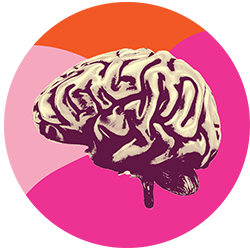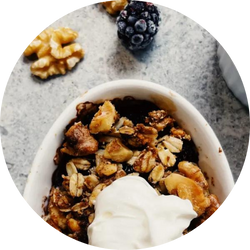HFC’S 5 BRAIN HEALTH HABITS
Research suggests that 45% cases of dementia may be preventable by adopting specific habits. Because Alzheimer’s can begin to develop 20-30 years before the onset of symptoms, there is no better time than NOW to start building a more dementia-resistant brain.
Here at HFC, we’re committed to teaching you how to better care for your brain and reduce your risk of cognitive decline. Your brain healthy journey starts HERE!

Sleep

Nutrition

Emotional Well-Being

Physical Exercise

Cognitive Fitness

Sleep
Sleep allows our bodies and minds to heal and organize themselves in preparation for another day. Think of sleep as the night crew that cleans an office building, so the work of the next day is unimpeded by yesterday’s paperwork, those muddy footprints the mailman tracked in, or the leftovers Kevin always forgets in the break room. A clean office is a productive office, and a rested brain is a productive – and healthy – brain.
Remember, when it comes to sleep, quality is just as important as quantity!
Here are some tips for a great night’s sleep and a well-rested brain:
- ✅ Get 7-9 hours of a sleep a day.
- ✅ Keep your bedroom cool and dark.
- ✅ Go to bed at the same time and
wake up at the same time. - ✅ Go to bed at the same time and wake up at the same time.
- ✅ Get morning sun.
- ✅Try brown noise to relax and block out outside noise.
- ✅Track your sleep.
- ❌ Avoid bright and blue light before bed. And if you wake up in the middle of the night, don’t check your phone!
- ❌ Avoid heavy meals and exercise 1-2 hours before bed.
- ❌ Avoid sleeping pills and other over-the-counter sleep remedies unless instructed by your doctor.
- ❌ Avoid alcohol in excess and caffeine late in the day.
Resources

Nutrition
We know we need to eat well. But did you know that, of all our organs, our brains are most easily damaged by poor diet?
Enter the MIND diet.
MIND stands for “Mediterranean-DASH Intervention for Neurodegenerative Delay.” DASH stands for “dietary approaches to stop hypertension.” This is less important and far more complicated than the diet itself.
To put it simply, the MIND diet is a blend of two diets proven to support brain health.
| What To Eat | How Much To Eat | Other Interesting Stuff |
|---|---|---|
| Berries | five ½-cup servings weekly | Blueberries are the best. Wild blueberries are even better. |
| Olive oil | two single-tablespoon servings daily | EVOO should replace butter, margarine, and vegetable oil.
🚨Myth-Buster: coconut oil, while often marketed as a brain-healthy oil or even as a tool to slow Alzheimer’s, is not either, according to science. Three things to look for when shopping for good EVOO:
|
| Leafy greens | seven cups weekly | The darker the better, think: kale, spinach, collard greens, swiss chard, bok choy, etc. |
| Nuts | snack on these most days | Allergic to nuts? Seeds are a good alternative. Flax, pumpkin, and sunflower, to name a few. |
| Beans | ½ cup every other day | Beans beans they’re good for your heart… and that means they’re good for your brain! |
| Whole grains | Include these daily | For example: oats, quinoa, dark rices |
| Fish | at least once a week | On the flip side: have fewer than four servings of red meat and meat products (like sausage) weekly. |
| Poultry | at least twice weekly | On the flip side: have fewer than four servings of red meat and meat products (like sausage) weekly. |
| Dark cocoa powder | Have fewer than five sweets weekly | and stick to dark chocolate when you do! |
Here’s a day’s worth of brain healthy recipes from HFC’s Chief Executive Foodie, Dr. Annie Fenn of Brain Health Kitchen:

Breakfast

Lunch

Dinner

Mocktail
Resources

Emotional Well-Being
Okay, we know this, but it warrants a reminder: stress is bad for us! A short daily practice of mind-body therapy can help us build dementia-resistant brains.
- ✅ Meditate
- ✅ Get outside in nature
- ✅ Be social
- ✅Declutter your space
- ✅Talk about your feelings with people who will listen without judgment
Resources
-
Listen
Science Explains How Meditation Impacts Brain Health & Function via Wellness Evolved
- READ
-
WATCH
Eight Relaxation Tips for Your Mental Well-Being via mind.org
-
DISCOVER
Try Kirtan Kriya, the 12-Minute Meditation Exercise Clinically Proven to Improve Cognition and Memory via The Alzheimer’s Research and Prevention Foundation
-
DISCOVER
Emotional Wellness Toolkit via The National Institutes on Health (también en español)

Physical Exercise
We knowwwww. Exercise can be daunting. There’s the lifting of heavy things, the putting them down… but trust us, it’s worth it. Exercise is GREAT for your brain!
The key to creating and sticking to an exercise plan is finding what works for YOU. It’s all about:
- ✅ Moving your body
- ✅ Raising your heart rate
- ✅ Sticking to it
The list of things improved by exercise is LONG. Here are just a few:
- ✅ Mood
- ✅ Long-term memory
- ✅ Sleep
- ✅ Stress and anxiety
- ✅ Growth of new brain cells
There’s a lot of science behind what kind of exercise to do for max brain health benefits. Every individual is different and your healthcare provider can help you determine what’s best for you. Here are two types of exercise to consider:
HIIT
AKA High Intensity Interval Training aka exercising in short, intense periods with rest in between.
Research shows that HIIT has a positive effect on the brain’s neuroplasticity.
Walking
Yup… if HIIT sounds overwhelming, start by simply walking.
A recent study found that older adults who took 9,800 steps each day were 50% less likely to develop dementia as a result. Those who took 3,800 steps daily saw a 25% reduction in risk.
And, speed matters! The faster you walk, the bigger the benefits. So, add a short speed walk (7-10 minutes) to your day to boost your brain health!
In general, shoot for 120 minutes of exercise that gets your heart pumping each week.

Cognitive Fitness
It’s like exercise, but for your brain.
One of the best ways to work out your brain is by teaching it new things. Active learning improves memory, creativity, mood, and self-esteem. Incorporating learning into your daily routine, such as reading, taking courses, or trying new hobbies, keeps your brain active and engaged.
Keeping your mind active is one of the most impactful ways to delay the onset of cognitive decline.
🚨Myth-buster! We hate to break this to you but… crossword puzzles are not the best exercise for your brain. They are great for improving vocabulary, but they are too passive and repetitive to stimulate your brain the way you would if you were learning something new. Remember neuroplasticity? Crossword puzzles may help maintain existing neural connections, but they are not likely to create new ones. To promote neuroplasticity, it’s important to engage in activities that challenge the brain in new and different ways.
Examples of CogFit exercises: (any activity that challenges and stimulates the brain)
- Learning a new language
- Playing a musical instrument
- Engaging in social activities
- Learning a new skill (such as cooking, woodworking, or painting)